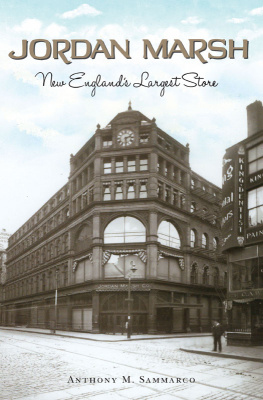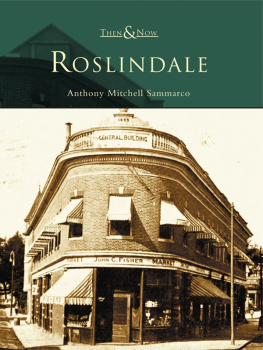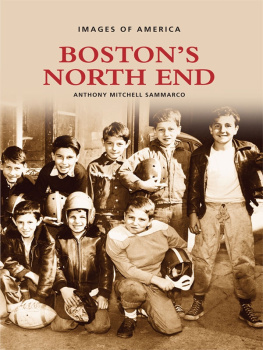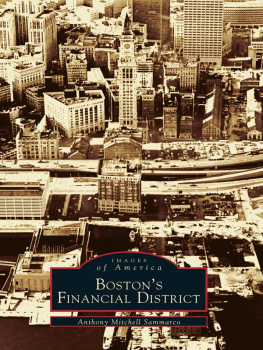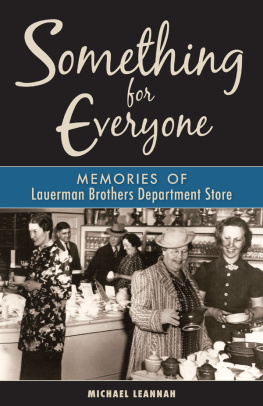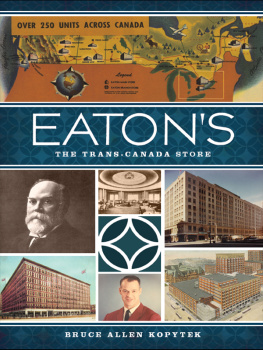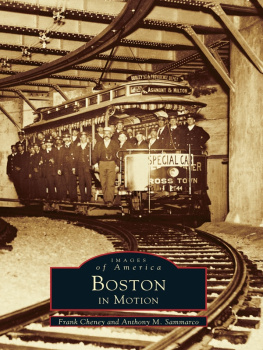


The cornerstone new building of Jordan Marsh was laid in 1949 at the corner of Chauncy Street, on the left, and Summer Street. The building was designed by the noted Boston architectural firm of Perry, Shaw, Kehoe and Dean and was to be built for the centennial of Jordan Marsh Company. Impressive in its design, the use of red brick and Ionic pilasters were a decided nod to Bostons architectural legacy.

Published by The History Press
Charleston, SC
www.historypress.net
Copyright 2017 by Anthony M. Sammarco
All rights reserved
All images are from the authors collection unless otherwise noted.
Page 1: An early trade card of Jordan Marsh & Co. was used from the turn of the twentieth century, when it was adopted by Eben Dyer Jordan Jr., who served as president of the store from 1895 to 1916. An armored metal-clad arm holds a dagger aloft with two winged griffins holding the quartered shield of Jordan Marsh & Co.
First published 2017
e-book edition 2017
ISBN 978.1.43966.359.2
Library of Congress Control Number: 2017948452
print edition ISBN 978.1.46713.790.4
Notice: The information in this book is true and complete to the best of our knowledge. It is offered without guarantee on the part of the author or The History Press. The author and The History Press disclaim all liability in connection with the use of this book.
All rights reserved. No part of this book may be reproduced or transmitted in any form whatsoever without prior written permission from the publisher except in the case of brief quotations embodied in critical articles and reviews.
For Cesidio Joe Cedrone
Behind this faade lies a storythe romance of a great New England institution.
It is worth telling. It should be worth reading. In the hope that the public may find it so, it is here set down.
Theres a time for looking backward and a time for looking forward
Eben Dyer Jordan
CONTENTS
ACKNOWLEDGEMENTS
The Jordan Marsh Company was a one-of-a-kind department store in Boston that seemed to offer to the public everything under the sun attractively displayed in its many acres of display space. After 1951, when its first suburban department store was opened at Shoppers World on Route 9 in Framingham, Massachusetts, the store was to evolve as a thriving department store chain with stores throughout New England and also throughout Florida. In the research and writing of this book, many people were very kind to share their memories and stories of this once fabled place, and I would like to thank them as well as the following people and institutions:
Susan Agaman; Anthony Artuso, Association of the First Corps of Cadets; Hope Lincoln Baker; the Barnstable Patriot, Debi Boucher-Stetson; Kathleen Walsh Beirne; Susan T. Belekewicz; Joan Bentinck-Smith; Mary G. Blake; the Boston Athenaeum, Catharina Slautterback; Boston Public Library, Henry Scannell, Research Services, with tremendous thanks; Charles Boston, Shopping Days in Retro Boston Blog; Alan Bourbeau; Sally Bradshaw; Ellen Bragalone; Karen Buscemi; John Canesi; Dolley Carlson; Elizabeth Carroll-Horrocks, Head of Special Collections, State Library of Massachusetts; Maureen McQuillen Cater; Calvary Cemetery, Boston; Hutchinson and Lina Cedmarco; Cesidio Joe Cedrone; Reverend Ellen Chahey and Edward Maroney; Michael Chesson; Dr. John and Lortetta Christoforo; Elise Ciregna and Stephen LoPiccolo; Barbara Clark; Edie Clifford; Colortek of Boston, Jackie Anderson and Jimmy Kwong; William and Frances Bellantoni Condaxis; Kaitlin Connolly; Therese Desmond and Meg Toyias, Milton Cemetery; Sal and Mary DiDomenico; Thomas Dunlay; Sandra Eaton; the marvelous world of eBay; Alberta Elias; Mary Anne English; Rosemary Donovan Finn; Barbara Smith Fitzgerald; Nancy Flemming; Forest Hills Cemetery, George Milley, Janice Stetz and Sally Alves; Charles Fraser; Greg French; Katherine Hickey Fulham; Vin Gandolfo; Bob Ganno; Jeannette Genova; Ann Colgan Gillis; Edward W. Gordon; Mary Ethel Grady; Jack Grinold; Donna Halper; John F. Hanafin; Helen Hannon; John P. Hickey Jr.; Steve Hill; Karen Hilliard; Chip Hilton; Historical Society of Cheshire County, New Hampshire; Historic New England, Lorna Condon; Hofmann-Figuen, Reinhard Hofmann, Martin Hofmann and Doreen Wieland; Martin and Deborah Blackman Jacobs; Jacqueline M. Jacquiot; Bradley Jay, WBZ 1030 Radio; the Jordan Marsh Facebook page; Stephen Kharfen; Donna Korman; Susan Greendyke Lachevre; Richard Leccese; Lauren Leja; Robin Liftman; Erica Lindamood, Old South Meeting House, Boston; Edward Mack, my initial editor; Dorothy V. Malcolm; Martin Manning; Constance L. Martin; Denis McGrath; Theresa McKillop; Nancy Dyer Mitton; the Mitton family; Alice Dick Moran; Hilda M. Morrill; Dee Morris; Mount Auburn Cemetery, Meg Winslow; Eddie Mulkern; Eileen Mullen; Dennis OBrien; Pat OMara; Orleans Camera; Stephen Owens; James Pardy; Stanley Paine, Stanley J. Paine Auctioneers; Mary E. Paul; Linda Pennington; Loumona Petroff; Richard Philpott; Christine Puccia; Lilian M.C. Randall; Robin H. Ray; Jordan Rich, WBZ 1030 Radio; Ann Pistorino Russell; Louise Russell; Dr. Dean Saluti and Marjorie Cahn; Richard Salvucci and Leslie Lehmann; Maria Saxe; Kimberly Effgen Sliney; J. Banks Smither, my editor; Special Collections Archives in the Massachusetts State House; Judith Sumner; Carolyn Thornton; Kenneth Turino and Chris Mathias; Warren Turino; University of Massachusetts, Archives and Special Collections, Joseph P. Healy Library, Boston, Joanne Riley and Andrew Elder; Grace Wagner, Massachusetts Historical Society; Ann and Thomas Walsh; Daniel White; Ellen and Thomas White; Nancy White; Lewis Whitlock; Jodiann Wise; and Cathryn A. Wright.

The Jordan Marsh Company corner tower with its massive clock was designed by Bradlee, Winslow & Wetherall and built in 1881 adjacent to the store designed on the left by Nathaniel J. Bradlee. At the turn of the twentieth century, the junction of Washington and Avon Street (formerly Avon Place) was called the busiest corner on Bostons busiest street.
Though Jordan Marsh had stores throughout Florida; in Albany, New York; Bedford, New Hampshire; Portland, Maine; and Warwick, Rhode Island, this book primarily deals with the flagship store in Boston and its suburban stores throughout New England from 1851 to 1995.
INTRODUCTION
Founded in 1851 by partners Eben Dyer Jordan and Benjamin Lloyd Marsh, Jordan and Marsh opened its first store with a capital of $5,000 on Milk Street in Boston selling linens, silks, cottons, calicoes, ribbons and assorted dry goods to discriminating Victorian Bostonians. Following the Civil War, after which the business had dramatically increased and additional space was needed, the store was successively moved to the Cruft Building on Pearl Street and then to the Free Stone Building at Winthrop Square and later to Washington Street, between Summer and Avon Streets. In the latter location, in its impressive five-story brownstone store designed by Nathaniel J. Bradlee, they unveiled the novel concept of department shopping all under one roof.
Next page
